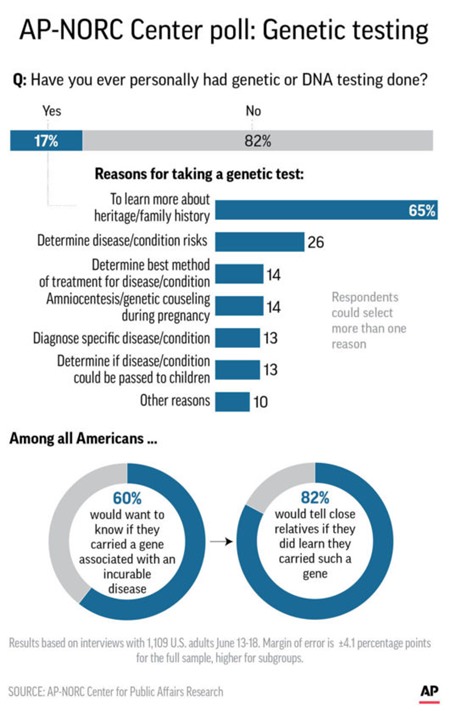
Washington (AP) – Would you want to know if you harbor a gene linked to Alzheimer’s or another incurable disease? A new poll finds most Americans would.
 Some 17 percent of Americans already have undergone at least one kind of DNA test, and 52 percent of the remainder say they’d like to, according to the poll from The Associated Press-NORC Center for Public Affairs Research released Thursday.
Some 17 percent of Americans already have undergone at least one kind of DNA test, and 52 percent of the remainder say they’d like to, according to the poll from The Associated Press-NORC Center for Public Affairs Research released Thursday.
Curiosity about ancestry is the main reason. But large segments of the public also want to know if they’re at risk for various medical conditions – even if they can’t do anything about it. In fact, 60 percent of people say they’d want to know if they carried a gene associated with a disease that’s currently incurable, the AP-NORC poll found.
The question is how they’d handle that information. For most diseases, whether you get sick depends on a mix of genetics, lifestyle and other factors.
“It’s really important for people to understand that it is a risk, not a destiny,” said Erica Ramos, president of the National Society of Genetic Counselors.
Lots of tests to choose from
Genealogy buffs can get clues about ancestry. DNA testing can help diagnose symptoms, predict risk of later health problems, or tell if prospective parents might pass on diseases such as cystic fibrosis. Doctors can tell if certain medicines are more or less likely to work based on genetics, what’s called precision medicine.
Some gene tests require just a credit card and mailing in a saliva sample, while others need a doctor’s order – and there are important differences.
What people want to know
Younger adults especially want to know what health conditions might lie ahead. Among those under 30, more than two-thirds are interested in genetic testing and of those, 65 percent say one reason is to learn if they might pass a disease to their children.
If they’re at risk for an incurable disease, 78 percent of the younger crowd would want to know.
And if they got that bad news, 8 in 10 people of all ages would tell siblings and children, family members who might harbor the same gene.
Who gets tested?
Those living in households making $100,000 a year or more are most likely to have had a gene test. Direct-to-consumer tests are paid for out-of-pocket, but insurance may cover DNA tests deemed medically necessary.
Trusting the results
Most people think genetic testing is at least somewhat reliable, but less than half call it very or extremely reliable, the poll found.
DNA testing isn’t foolproof, said Ramos, the genetic counselor. There can be false alarms, the reason medical labs and the most popular direct-to-consumer companies must meet strict testing rules. But there are loopholes: Say after ancestry testing, you download the “raw” genetic data generated to analyze your heritage and send the file to a second company to interpret whatever health information is inside. Those companies may not be certified for medical diagnosis – meaning it’s important for a doctor to verify any scary result.
The flip side: False reassurance. Direct-to-consumer tests for breast cancer risk, for example, only look for a few mutations. If cancer runs in the family, you may need a doctor-ordered test that examines a variety of genes and mutations, Ramos said.
A genetic counselor can help explain the different tests and what results mean.
Privacy is
complicated, too
Half of Americans are very or extremely concerned about companies sharing their genetic data without their knowledge, and roughly a third have the same concerns about medical researchers and doctors, the poll found.
Remember how investigators used a free genealogy website to track down a suspected California serial killer? Half of people think genetic data should be used to help solve crimes only with the consent of the person tested, a third think it’s OK without that consent – and 13 percent don’t think law enforcement should use it at all.
Crime aside, federal law offers some privacy protections for DNA testing in medical settings – but check privacy policies on direct-to-consumer websites.
The AP-NORC poll of 1,109 adults was conducted June 13-18 using a sample drawn from NORC’s probability-based AmeriSpeak Panel, which is designed to be representative of the U.S. population. The margin of sampling error for all respondents is plus or minus 4.1 percentage points.
Respondents were first selected randomly using address-based sampling methods, and later interviewed online or by phone.
Online: AP-NORC Center: http://www.apnorc.org/





